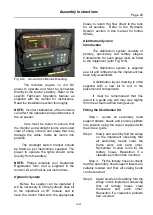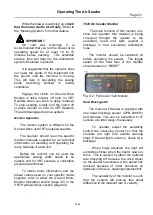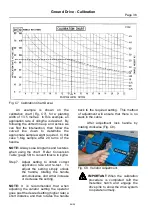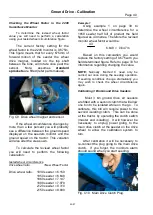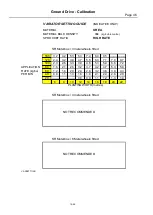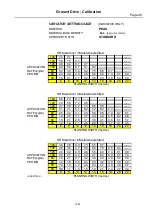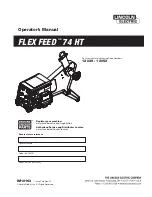
GROUND DRIVE - CALIBRATION
Page
04/04
34
Introduction
The calibration procedure involves the
rotation of the metering system by hand to
simulate the coverage of a certain area. A
material sample needs to be collected and
weighed to calculate the application rate.
There are several ways to calibrate your
seeder but only 3 methods will be
discussed here.
Method B
is the
most
common
and relates to taking a sample
equal to 1/20
th
of a hectare.
When calibrating the machine it must
be remembered that only one type of
material should be measured at one time.
This will require the operator disconnecting
the front, middle or rear metering system.
For further information on calibrating a
3 bin machine refer to page 40.
The variator settings may show a
slightly different value for the same material
output and for this reason each variator
should be set independently. For an
approximate setting refer to the appropriate
‘Variator Setting Guide’ (page 41 to 55).
When calibrating ensure that there is
enough material in the bins. In most cases
2 bags will be sufficient.
For very low or high rates it may be
necessary to make minor adjustments to
the metering system. Refer to the Meterbox
Assembly section of this manual for further
information.
It must be remembered that this style
of seeder is dependent upon a correct
wheel diameter for its operating accuracy.
If this diameter is altered, (e.g. incorrect
tyre fitted, wrong tyre pressure or extreme
ground conditions), inaccurate metering
may occur. Refer ‘Method C’ for checking
the wheel circumference if extremely
accurate metering is desired. All data in
this section was compiled on medium black
worked ground.
IMPORTANT
BEFORE
CALIBRATION
OR
OPERATION,
CHECK
THAT
THE
METERING SHAFTS TURN FREELY.
Material in the bin will compact if
transported after filling or left over night
(especially fertilizers). For this reason, it is
important that you check the metering
system turns freely before calibrating and
operation. Use the handle supplied and fit to
the right-hand side of the metershaft (Fig.
C1).
DAMAGE MAY OCCUR TO THE VARIATOR IF
THE SYSTEM IS NOT CHECKED.
Fig. C1 Checking meter shaft turns freely.
During operation it is important to check
that the product being metered is going out
at the calibrated rate. Variations may occur if
product is damp or material does not flow
easily. Check rate is correct by monitoring
bin levels while actually seeding.
Method A:
For winter rates only.
This is a method that requires no
calculations and is suitable for most mid
range seeding applications.
By using the ‘Calibration Chart’ on the
side of the seeder bin it is possible to set the
metering systems application rate.
For rates less than 20kg/ha or higher
than 140kg/ha refer to ‘Methods B or C’.






